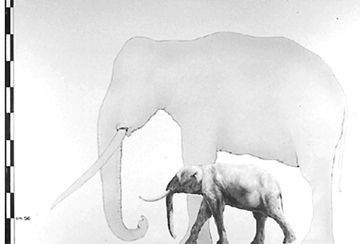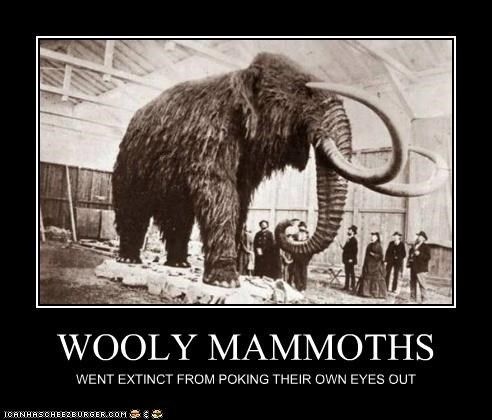Up to now there's no quite a solid answer as to why Mammoths got extinct knowing the fact that they still had existed when the pyramids are built.

Mammoth's size compared to today's Elephant.
Researchers thought that:
Disease or humans may have wiped out the last mammoths; climate change probably did not.
At least a few hardy individuals were still hanging on as late as 1700 B.C.
The last known population of woolly mammoths, roaming a remote Arctic island long after humans invented writing, were wiped out quickly, reports a study released Wednesday.
The culprit might have been disease, humans or a catastrophic weather event, but was almost certainly not climate change, suggests the study, published in the Proceedings of the Royal Society B.
Exactly why a majority of the huge tuskers that once strode in large herds across Eurasia and north America died out toward the end of the last ice age has generated fiery debate.
Some experts hold that mammoths were hunted to extinction beginning some 10,000 years ago by the species that was to become the planet's dominant predator -- humans.
Others argue that climate change was more to blame, leaving a species adapted for frigid climes ill-equipped to cope with a warming world.
It has long been known that a colony of woolly mammoths survived up until about four thousand years ago on what is today Russia's Wrangel Island, north of Siberia in the Arctic Ocean.
Radiocarbon dating shows that at least a few hardy individuals were still hanging on as late as 1700 B.C.
To better understand their demise, researchers led by Anders Angerbjorn of Stockholm University analyzed bits of mitochondrial DNA -- genetic material inherited through females -- extracted from bone and tusk.
"It could be that the island was simply too small to support a long-term viable mammoth population," the authors speculated.
About 7,600 square kilometers (2,900 square miles) in area, Wrangel Island is a bit smaller than Corsica or Puerto Rico.
Once connected to the mainland by an ice bridge, Wrangel was gradually cut off by water 12,000 to 9,000 years ago.
A loss of genetic variation could also have resulted from the shift in climate as Earth entered the so-called interglacial period, a boon for many animals, but not for the giant tuskers, the study said.
To their surprise, however, the researchers found that genetic diversity remained stable, and even increased slightly, right up to the bitter end.
"This suggests that the final extinction was caused by a relatively sudden, rather than gradual, change in the mammoths' environment," the study said.
Humans appear to have arrived on the island about 100 years after the huge mammals had vanished, according to archeological data.
This would exculpate Homo sapiens from killing off the last mammoths, though it is possible humans arrived earlier but left no trace.
That leaves climate or disease, the researchers hypothesize, noting that a sudden event -- a mega-storm, for example -- or a novel bacteria or virus could have wiped out the remaining population.
The fate of mammoths on Wrangel Island, they caution, is not necessarily a microcosm for the species as a whole because islands exert unique evolutionary pressures on animal species.
One theory is that expanding forests in Europe and parts of Asia robbed the grass-eating mammoths of their preferred habitat, gradually starving them to death.
Some funny thought would be:




